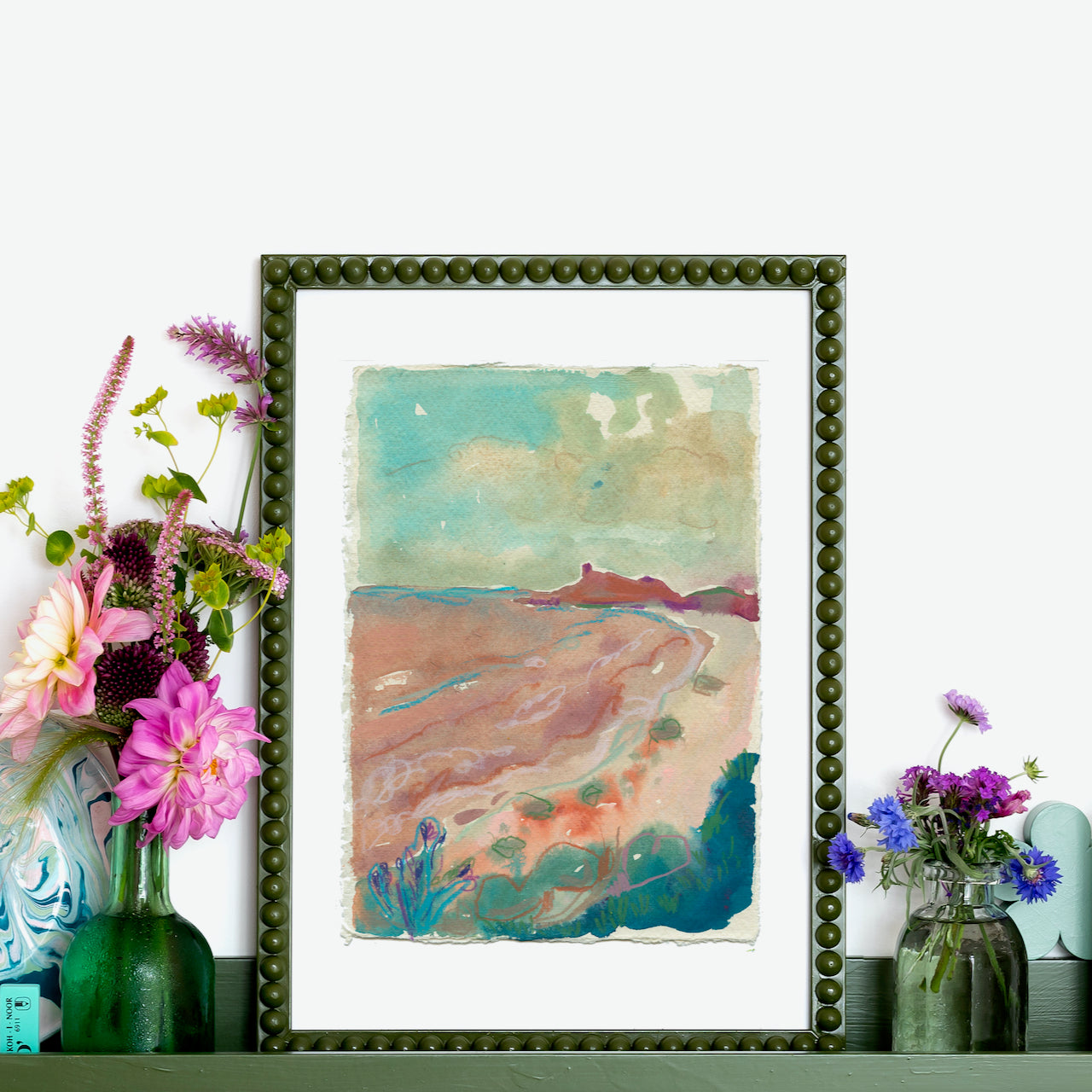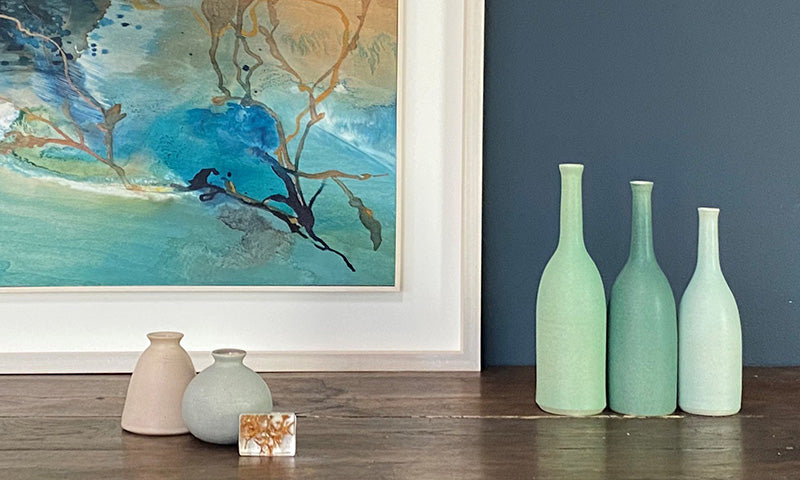Good on Paper: Lucy Innes Williams

Falmouth based Lucy Innes Williams first exhibited her elegant floral work with us in spring 2022 and immediately won a host of admirers with her beautiful blowsy blooms. I personally couldn't resist and the chosen piece now looks wonderful on my bathroom wall!
Although Lucy often works on paper with her floral studies, I asked her to consider trying a new subject matter for Good on Paper.

We know you best at the Byre Gallery for your beautiful floral work, but it’s fantastic to have some seascapes too which are quite a departure for you, how did you enjoying creating these?
Often my daughters ask me if I paint anything other than florals, which always makes me laugh. As a fine art student I used to paint everything but florals, and as I’ve got older they have spoken to me more and more.
Seascapes are such a calming, universal scene to create and I have found these peaceful and grounding to paint. I definitely want to paint more on a large scale. I have a lot of energy building for this style of painting and once that happens, I just have to see it through! I have been asked for quite a few years whether I would paint seascapes and I’ve always resisted, I’m not sure why really now.
Do you approach a seascape in a different way to one of your floral works?
The approach to both starts with drawing and sketching. I might then have the loosest of outlines on the base layer of the final painting. I have a clear idea of how I want to divide up the space and will add layers of colour washes and areas of colour as I go. It is important to me that there is a very obvious brush and stroke mark both in the background and foreground. For both floral works and seascapes, I like to add detail and structure into the work at the end. It is this challenge to bring a scene into focus that I most love about painting. I tend to use a dark ink for floral works but for seascapes, I wanted more colourfields and so have been using my beloved Caran D’Ache Luminance pencils which have divine rich colour.

What part of the coast was inspiration for you?
Cornwall’s coastline is hugely varied and wild in a way that makes my heart sing. I am quite a macro-person visually normally, and by that I mean I like to zoom in on tiny details, which I think is why I love flora so much. When it comes to seascapes though, the wilder and big-sky the better. I like storms, heavy skies, wind and trees that have been shaped by the will of the wind.
I live in Falmouth and so my stomping ground is The Helford River and all its wonderful beaches, Pendennis Head, The Carrick Roads and the beaches of Gyllyngvase and Maenporth. Recently I’ve spent a good bit of time in St Ives and a many of my recent works feature its varied beaches including Porthmeor, Porthgwidden and Bamaluz. Growing up, I spent summers on the Lizard Peninsula and so Kynance and the flat wilds around Goon Hilly are still magical to me. More recently I’ve discovered the cliffs around St Just, and am always stunned by the journey aross tin-mining country on the way to Botallack mines. This area is next on my list to paint.
One of my favourite places in Cornwall (maybe even the world!) is Trebah Gardens on the Helford. Its magical sub-tropical gardens lead down to a beach and I draw huge inspiration from the scale of their plants and flowers there. I am lucky enough to have been invited to mount an exhibition there for March - April 2024 and am busy creating sea and flowerscapes for this large space. Their new, slightly more formal court gardens really pack a punch, texture and pattern-wise.
Did you do any work on plein air or was it in the studio?
I paint in both ways. Generally I will sketch and photograph an area on walks, and will then head back to the studio to work on a painting. I often work in ‘collections’ and will paint multiple pieces at the same time.

Will we continue to see this new subject matter in future?
Yes, in a word. More to come definitely.
You’ve done a lot of work on paper in the past but have moved onto panel more recently, did you enjoy a return to working on paper?
I’ve enjoyed a return to paper for this show. I’ve been searching for a paper I enjoy painting on which also has sufficiently beautiful edging.
I’ve recently painted on board in preparation for an outdoor art event, Form Falmouth that I showed at last month. It’s simply more robust in the Cornish mizzle!

What is the biggest difference for you between working on paper and panel?
The surface I paint on is hugely important to me and it really affects the feel and mood of the painting, at least in its execution if not how it’s read by the viewer. I have historically enjoyed painting on a super-smooth paper because of how it holds paint on the surface of the paper or board. The paint becomes suspended in a really satisfying way which allows the viewer to see brush marks and intentional mark making where colours bleed into one another.
More recently I’ve embraced a rougher texture and watercolour paper which absorbs more of the paint. Both types of paper and board allow for the expressive nature of paint to contribute to the movement I try and achieve in my paintings.
I like using both mediums, but probably feel I can be a little rougher and more instinctive on board because it’s a tougher surface. I’d be more likely to paint en plein air on board, but I sketch outside most on paper in little sketchbooks. I don’t often refer back to my sketchbooks when completing a finished painting. The sketchbook is more just to loosen up my hands and get a ‘feel’ for a space and its lines and curves. Does that make sense? It does to me when I’m standing shivering in the wind and want to get a sketch down on paper in a few short minutes!

You normally frame your work, and often in beautifully coloured frames, have you had any thoughts about how these works could be framed?
I work pretty much exclusively with Kitty of Banana Shed Framing in Penryn. I cannot recommend her highly enough and I think her work is a pretty open secret in the area. Everyone is in the queue for Kitty!
I spend a lot of time thinking about my frames and colour choices before visiting Kitty, and tend to use Farrow & Ball colours for their range and depth. The colours I choose either contrast the colour choices of the painting, or pick out a colour in the work that I’d like to highlight. As an unabashed colourist, I really believe that the frame should work with the painting rather than act as a silent partner simply holding the work to the wall!
I tend to use a simple tray frame for work on boards, with a nice amount of space around them. For these new seascapes, I would envisage the works framed with a delicate tray frame and c. 5 cm space to the lovely edges of the khadi paper I’ve painted on. The works would look best floated to highlight this edging, which I chose to suit the rough mood of the seascapes.

